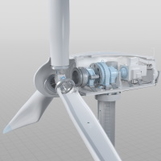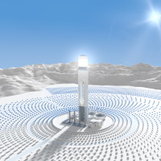Energy Generation for Green Hydrogen

Hydrogen is not automatically climate-friendly. The production of the alternative energy carrier requires the use of energy. If this comes from conventional energy sources such as natural gas or coal, the hydrogen produced in this way is no longer "green" either. In order to produce and use hydrogen in a climate-neutral manner, electrolysis—the splitting of water into acid and hydrogen—must be at the beginning of its value chain, using electricity from renewable sources such as wind or solar power.
Pepperl+Fuchs offers numerous components that optimize the energy yield in wind and solar power plants, for example, and therefore ensure maximum efficiency.

Whether on land or on the high seas: To achieve a high energy yield in wind turbines, both the rotor blades and the nacelle of a wind turbine must be optimally aligned with the wind. To make this possible, various sensors from Pepperl+Fuchs are used. Absolute rotary encoders on the wind turbine measure the position and rotation of the nacelle as well as the position and angle of the rotor blades. Incremental rotary encoders, on the other hand, measure the generator speed. To prevent damage to a wind turbine's structure, vibration and acceleration sensors also record the vibration of the nacelle and the entire tower. Lightning protection modules from Pepperl+Fuchs additionally prevent control technology and signal transmission from being damaged by lightning strikes.

The more solar radiation, the more energy a concentrated solar power (CSP) plant generates. Since the sun moves throughout the day, the solar collectors in CSP plants are always adjusted to the position of the sun in order to optimize the energy yield. To make this possible, the orientation of the collectors must always be accurately recorded. This is where inclination sensors and encoders from Pepperl+Fuchs come into play. The high-precision F199 inclination sensor, for example, detects the horizontal alignment of Fresnel collectors and enables their optimal positioning relative to the absorber. In solar tower power plants, on the other hand, not only the horizontal but also the vertical alignment of the heliostats plays an important role in optimizing the energy yield. Here, encoders and inclination sensors from Pepperl+Fuchs are used to precisely detect the alignment in both axes and enable optimal positioning of the collectors.
- Ask an Expert
- Cross Reference Request
- Check order status
- News
- NetPartner Login
- Subscribe to Gate-Way, our Process Automation Division e-newsletter
- Service Level Agreements for ecom instruments
- Find a Local Distributor or Representative
- Literature
- Technologies
- Control System Solutions
- Download Technical Documents
- Press Releases
- International Trade Shows








 +1 330 425-3555
+1 330 425-3555